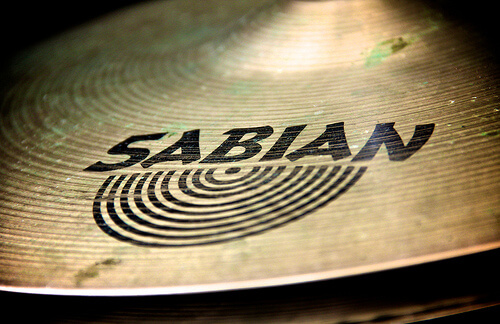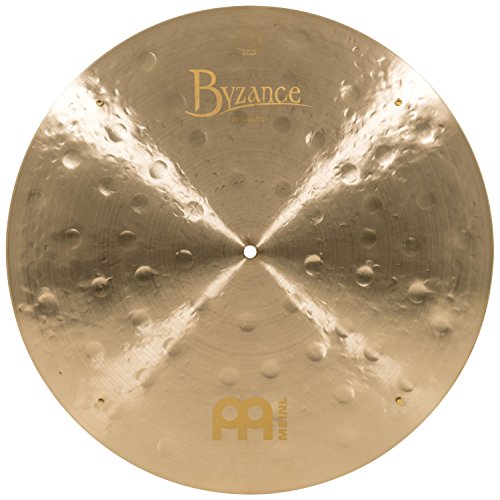The main decisions you’ll have to make when you’re narrowing down which cymbal to buy will be regarding the cymbal diameter and whether you get a cymbal that’s riveted. Most players find a ride diameter of 20” to 22” works best for jazz, while the choice of rivets or no rivets tends to be a matter of personal preference, with adherents of both styles numbering among the modern greats.
If you’re looking for the best jazz cymbals, check out the 4 options below:
Jazz Cymbal 1: Zildjian K Constantinople 22” Medium Ride
The hammering techniques Zildjian uses to craft this jazz ride cymbal are a mix of the traditional and the modern. The end result of this is a cymbal that has the bright edge of a vintage cymbal but with a richer and darker tone on the sustain that makes it perfect for the jazz musician.
Because it’s made of high-quality brass to Zildjian’s exacting standards, you can get a classic sound from a cymbal (see full specs) that’s far more consistent than the vintage models you’ll find on the market—and one that will last you for years once you put it on your kit. You’ll be amazed by the range and depth of tonal options the Constantinople offers you, giving your sound that extra color you’re looking for.
https://www.youtube.com/vQLfeFYaKVY
Jazz Cymbal 2: Zildjian K Custom 20” Dark Ride
Another dark cymbal option from Zildjian that’s great for jazz—and comes in at a slightly lower price point—is the K Custom model. The sound of this one is fuller than the Constantinople above, with a slightly drier tone and dark, warm sustain. At the same time, both the attack and the decay are quicker than a traditional Zildjian K model.
The articulations of this cymbal (see full specs) are perfect for the jazz drummer. It gives your stick attacks a clearer definition than most cymbals, giving you a ride that can both do powerful accents and give your sound more range. Hands down, this is one of the best jazz cymbals for the money.
https://www.youtube.com/SRMVMl45rko
Jazz Cymbal 3: Meinl Cymbals B20JCR Jazz Club Flat Ride
The “flat ride” or “club ride” designed by Wolfgang Haffner was designed specifically for the jazz drummer. Don’t take this to mean it can’t do anything else; club rides can work wonderfully in pop, rock, and funk styles, but their presence and smooth warm tone still make them a favorite for jazz in both the club and the studio.
This cymbal’s four rivets give it a sizzling sustain. It’s hand-hammered with big hammer marks that give it a dark color and smooth, musical tone of vintage jazz rides. If you’re a traditional jazz player, especially if you play in a lot of trios and small combos where the rich sustain will have more chance to shine through, this is the jazz ride cymbal to get.
https://www.youtube.com/OMDEVWyuh3c
Jazz Cymbal 4: Sabian SBR2012 Pure Brass Ride
You don’t have to spend tons upon tons to get a quality jazz cymbal. The pure brass ride from Sabian in general costs about much less than the Meinl cymbal above (though check current prices) and works beautifully in a wide range of musical styles, including jazz.
The sound from this cymbal is bright and focused. It’s been hammered to bring out the best sonic qualities of the brass used in its construction, with a smooth natural finish that helps it to look as good as it sounds. Sabian’s entire SBR line is designed for versatility and value, and especially if you’re setting up a jazz kit for a relatively young player, they leave her a lot of room to discover her own sound.
Size Considerations of the Best Jazz Cymbals
There are two factors in play when we talk about the size of a cymbal—both its diameter and the thickness of the metal used in its construction. You’ll find cymbals available along a range for each of these characteristics. While thickness and diameter won’t have as much impact on the sound as the technique of hammering and metal used, they’ll let you tweak your sound once you’ve find the basic cymbal style you’re looking for.
When it comes to the thickness of the cymbal, a good rule of thumb is that the thinner the cymbal, the darker the sound. Increasing the thickness of the cymbal also raises its maximum volume, but the trade-off for that is it must be struck harder to produce a clear, good sound. Generally speaking, the greater dynamic variety in jazz calls for more sensitivity from the cymbals than rock or pop music, which is why many players go with a medium or medium thin ride cymbal for jazz. This weight gives a good balance of dark tone color with crisp articulation and lets you be especially sensitive with your dynamics.
The thickness of the cymbal will also impact its durability, of course, simply because a thicker metal is less likely to become damaged or cracked. The quality of the metal and hammering also have an impact on the durability, arguably more of one than the thickness of the cymbal. If you have a particularly hard strike, however, you may find that thin or even medium-thin cymbals take more damage than you’d like. A medium-weight instrument will probably be a better fit for the best jazz cymbal in your case by preventing damage in the future.
The diameter of the cymbal will also have an impact on the ultimate sound. The diameter of your cymbal largely affects its pitch. Generally speaking, the wider the jazz ride cymbal, the lower the sound will be. It will also affect the length of the sustain, with wider cymbals ringing a little longer. By choosing the right combination of thickness and diameter you can fine-tune your sound, getting that perfect shimmer you’re looking for out of a piece on your jazz kit.








